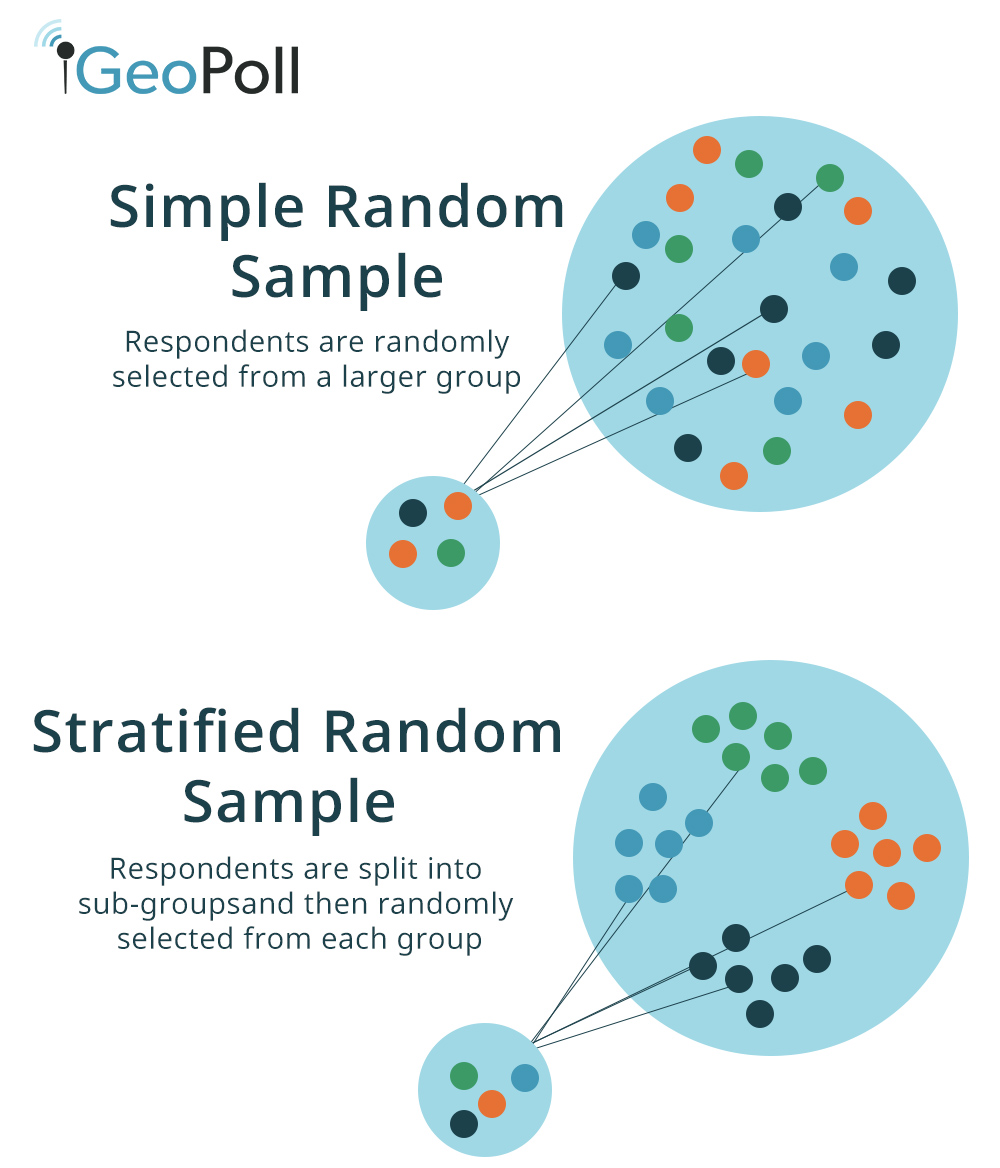The sample used to conduct a study is one of the most important elements of any research project. A research sample is those who partake in any given study, and enables researchers to conduct studies of large populations without needing to reach every single person within a population. Sample source, sample size, and how the sample was selected all have an effect on the reliability and validity of a study’s results – that is, how much those reading the results can trust that they will continue to produce the same results over time, and that they represent the wider population being studied.
In this series of blog posts, GeoPoll will outline the various aspects that make up a sample and why each one is important. First, we will examine how sample is selected and the differences between a probability sample and a non-probability sample.
Probability Sample vs Non-Probability Sample
 There are two main methods of sampling: Probability sampling and non-probability sampling. In probability sampling, respondents are randomly selected to take part in a survey or other mode of research. For a sample to qualify as a probability sample, each person in a population must have an equal chance of being selected for a study, and the researcher must know the probability that an individual will be selected. Probability sampling is the most common form of sampling for public opinion studies, election polling, and other studies in which results will be applied to a wider population. This is the case whether or not the wider population is very large, such as the population of an entire country, or small, such as young females living in a specific town.
There are two main methods of sampling: Probability sampling and non-probability sampling. In probability sampling, respondents are randomly selected to take part in a survey or other mode of research. For a sample to qualify as a probability sample, each person in a population must have an equal chance of being selected for a study, and the researcher must know the probability that an individual will be selected. Probability sampling is the most common form of sampling for public opinion studies, election polling, and other studies in which results will be applied to a wider population. This is the case whether or not the wider population is very large, such as the population of an entire country, or small, such as young females living in a specific town.
Non-probability sampling is when a sample is created through a non-random process. This could include a researcher sending a survey link to their friends or stopping people on the street. This type of sampling would also include any targeted research that intentionally samples from specific lists such as aid beneficiaries, or participants in a specific training course. Non-probability samples are often used during the exploratory stage of a research project, and in qualitative research, which is more subjective than quantitative research, but are also used for research with specific target populations in mind, such as farmers that grow maize.
Generally speaking, non-probability sampling can be a more cost-effective and faster approach than probability sampling, but this depends on a number of variables including the target population being studied. Certain types of non-probability sampling can also introduce bias into the sample and results. For general population studies intended to represent the entire population of a country or state, probability sampling is usually the preferred method.
Types of Probability Sampling
 There are several sampling methods that fall under probability sampling. In each method, those who are within the sample frame have some chance of being selected to participate in a study. Four of the common types of probability sampling are:
There are several sampling methods that fall under probability sampling. In each method, those who are within the sample frame have some chance of being selected to participate in a study. Four of the common types of probability sampling are:
Simple Random Sample: The most basic form of probability sampling, in a simple random sample each member of a population is assigned an identifier such as a number, and those selected to be within the sample are picked at random, often using an automated software program.
Stratified Random Sample: A stratified random sample is a step up from complexity from a simple random sample. In this method, the population is divided into sub-groups, such as male and female, and within those sub-groups a simple random sample is performed. This enables a random sample that is representative of a larger population and its specific makeup, such as a country’s population.
Cluster Sample: In cluster sampling, a population is divided into clusters which are unique, yet represent a diverse group – for example, cities are often used as clusters. From the list of clusters, a select number are randomly selected to take part in a study.
Systematic Sample: Using a systematic sample, participants are selected to be part of a sample using a fixed interval. For example, if using an interval of 5, the sample may consist of the fifth, 10th, 15th, and 20th, and so forth person on a list.
Types of Non-Probability Sample
In non-probability sampling, those who participate in a research study are selected not by random, but due to some factor that gives them the chance of participating in a study that others in the population do not have. Types of non-probability sample include:
Convenience Sample: As its name implies, this method uses people who are convenient to access to complete a study. This could include friends, people walking down a street, or those enrolled in a university course. Convenience sampling is quick and easy, but will not yield results that can be applied to a broader population.
Snowball Sample: A snowball sample works by recruiting some sample members who in turn recruit people they know to join a sample. This method works well for reaching very specific populations who are likely to know others who meet the selection criteria.
Quota Sample: In quota sampling, a population is divided into subgroups by characteristics such as age or location and targets are set for the number of respondents needed from each subgroup. The main difference between quota sampling and stratified random sampling is that a random sampling technique is not used in quota sampling; For example, a researcher could conduct a convenience sample with specific quotas to ensure an equal number of males and females are included, but this technique would still not give every member of the population a chance of being selected and thus would not be a probability sample.
Purposive or Judgmental Sample: Using a purposive or judgmental sampling technique, the sample selection is left up to the researcher and their knowledge of who will fit the study criteria. For example, a purposive sample may include only PhD candidates in a specific subject matter. When studying specific characteristics this selection method may be used, however as the researcher can influence those who are selected to take place in the study, bias may be introduced.
GeoPoll Sampling Methods
GeoPoll uses all of the sampling approaches described above based on the needs and can use probability-based methods for our sample selection, including stratified random sampling, to build nationally representative samples. To learn more, please contact us.



